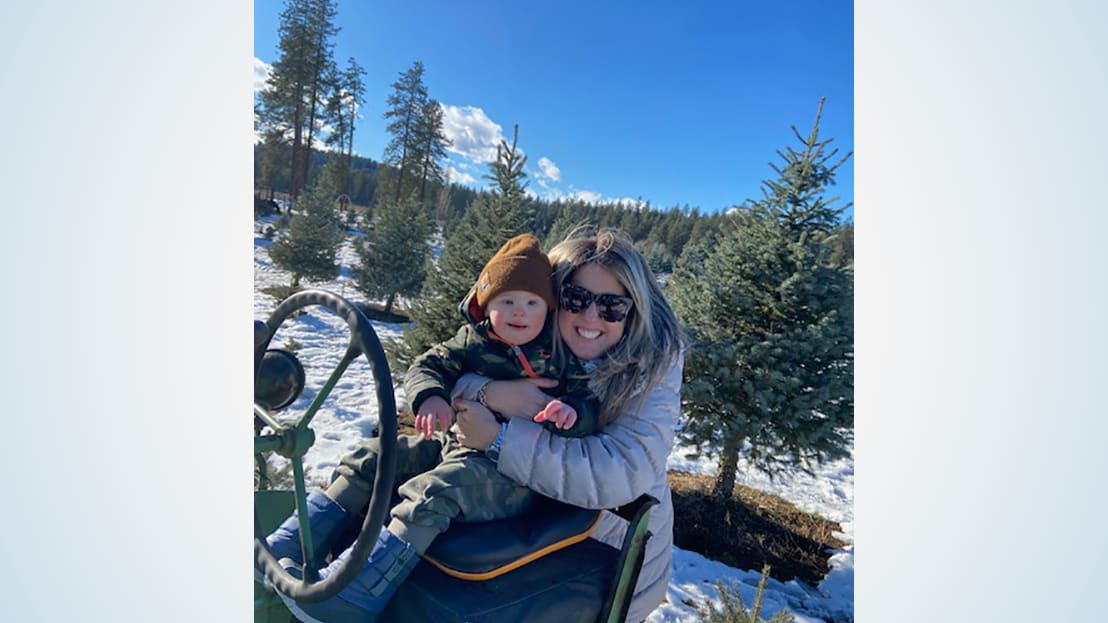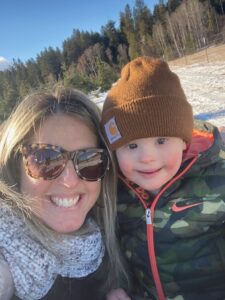‘It’s OK to be different’ – Deaconess receptionist and mother advocates for Down syndrome awareness

If you visit MultiCare Deaconess Hospital on March 21, you may see staff sporting colorful socks or find a young boy’s face smiling at you from the cardboard sleeve of your morning coffee.
The 3-year-old boy is Tucker. His mother, Crystal Ossello, is a receptionist at Deaconess and organized the activities in honor of Down Syndrome Awareness Day. Tucker was diagnosed with this genetic condition months before he was born.
“When I got the diagnosis, it was really hard,” Ossello says. “Nobody wants to be told anything different than ‘You’re having a healthy child.’”
Now, she says she wouldn’t change her son for anything.
Ossello sits on the board of DS Connections Northwest, a Spokane-based nonprofit that serves as a network of support, resources and relationships for those with Down syndrome, their families and community. She brings that passion for advocacy and education to Deaconess.
Like many other parents, Ossello didn’t know much about Down syndrome when her family received the diagnosis. Working as a flight attendant at the time, she recalls seeing a woman and a child with Down syndrome board a plane.
“It just struck me differently,” she says. “For me, it was comforting. … I didn’t know there was a whole community out there.”
From there, Ossello began doing research and connecting with others, which helped her family navigate the unknowns and trust that it would be OK even if things looked different.
“When I was told about Tucker, all I wanted was for somebody to tell me it was going to be OK,” she says. “And now look at him. He’s a great child … He just does things in his own way.”
What is Down syndrome?
Down syndrome is the most common chromosomal condition in the United States, impacting approximately 6,000 newborns each year.
Sometimes referred to as trisomy 21 (about 95 percent of cases), the condition is due to an extra 21st chromosome at birth, which impacts how the body and brain develop, often causing mental and physical challenges. The two other primary types of Down syndrome are translocation Down syndrome (about 3 percent of cases) and mosaic Down syndrome (about 2 percent of cases).
The impact of Down syndrome varies greatly, as it’s a broad spectrum. While some with the condition are high functioning and can live independently, others may require 24-hour, lifelong care. Some of the most common physical features include:
- Flattened face, especially bridge of nose
- Almond-shaped eyes that slant up
- Short neck
- Small ears/hands/feet
- Tongue that sticks out of the mouth
- Tiny white spots in iris
- Single line across palm of hand
- Small pinky fingers that sometimes curve toward thumb
- Poor muscle tone
- Loose joints
- Shorter in height
Prenatal screening and testing can identify individuals at increased risk of having a baby with Down syndrome, and other more involved diagnostic tests are available to identify the condition before the child is born, says Kari Tanta, PhD, OTR/L, FAOTA, rehabilitation manager for Mary Bridge Children’s Therapy Services.
“This is advantageous for families,” she says. “We help families receive appropriate prenatal care, know what to expect, and it allows them to start researching and setting up services from day one.”
Early intervention and the family
Tanta stresses the importance of early intervention, as many families will require a variety of support services, including occupational, physical and speech therapy. Starting sooner may allow a child to develop skills at a rate closer to that of a child without Down syndrome.
The exact services vary depending on the child, but often all three disciplines of therapy are needed to help with common challenges, such as low muscle tone, coordination, cognitive skills, speech, feeding and playing.
“It’s about helping the child to develop their skills so they can walk, run, jump and throw a ball, or be able to keep up with their siblings and peers and play,” Tanta says. “They just need extra help because they have things working against them.”
Therapy is customized to the child, their family and their shared goals, she says. One family may want to focus on walking to make playing with their siblings easier; another on speech or social skills; another on behavior if their child is prone to outbursts that make family outings challenging.
The therapy team also provides activities for families to work on at home, as well as Sibshop, which gives siblings of children with Down syndrome and other developmental needs a safe space to be with other siblings, ask questions and have fun, Tanta says.
Every path is different
Therapists use various assessments to compare the performance of a child with Down syndrome to their peers. These tests help determine which services and goals are most realistic, Tanta says, but that by no means limits the child or their goals.
“Our lives are always changing and expectations of our world change,” she says. “We’re never going to put a limit on a child’s potential, because we just don’t know.”
While some individuals may never cognitively develop past elementary school age, Tanta says it’s important not to rule out the possibility. Her teams don’t want to give false hope, but they do want to be hopeful, especially with so many advancements and growing inclusivity.
“There’s so much more technology for communication, even for those who don’t develop verbal skills,” she says. “I’m also so excited for young adults with Down syndrome because so many corporations are welcoming to people with differences and finding places for them to work.”
There is always room for growth, Tanta says, including access to support services as patients age out of children’s programs, as well as in community acceptance. And as with any condition, stigma and stereotypes still exist.

Don’t make assumptions
“Sometimes people treat those with Down syndrome like they don’t have any feelings,” says mom Ossello. “It’s easy to be like, ‘Oh, they don’t know.’ But they have emotions just like everyone else.”
She often hears stereotypes, such as the idea that people with Down syndrome are always happy, or that they can’t feel pain due to low muscle tone. Although Tucker is nonverbal, she says he expresses emotions in other ways and, when in pain, shows signs only 15 to 20 seconds after another child might.
Some with Down syndrome will need assistance with many aspects of life, but others can do things like play sports or hold jobs. Regardless of their cognitive ability, Ossello says it’s most important to empower them to try.
“His life matters and he should get to experience all the same things as his peers,” she says. “Everyone has insecurities as a kid, and it’s important for us to remember that it’s OK to have a child with Down syndrome or to have Down syndrome. It’s OK to be different.”
Resources
Mary Bridge Children’s Rehabilitation and Physical Therapy
MultiCare Adult Development Clinic




